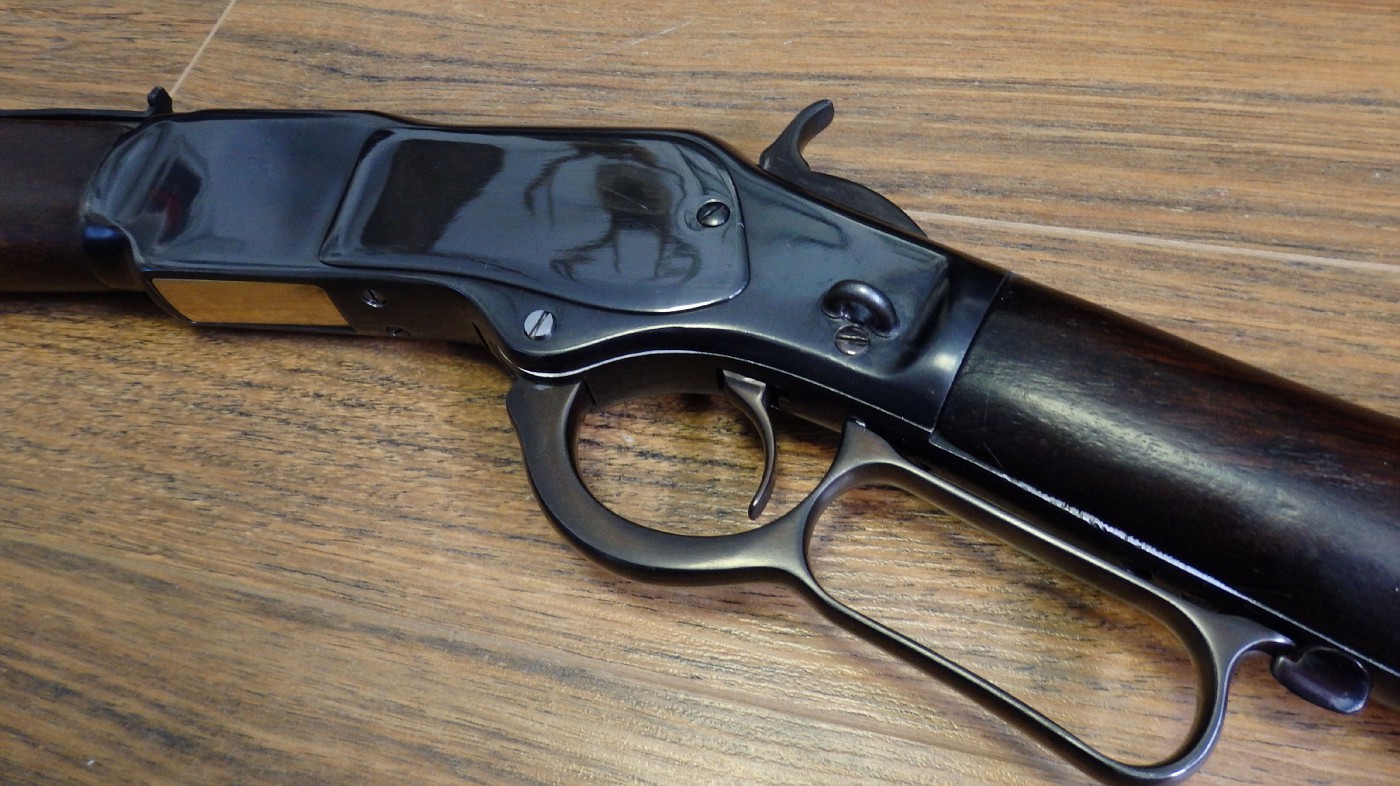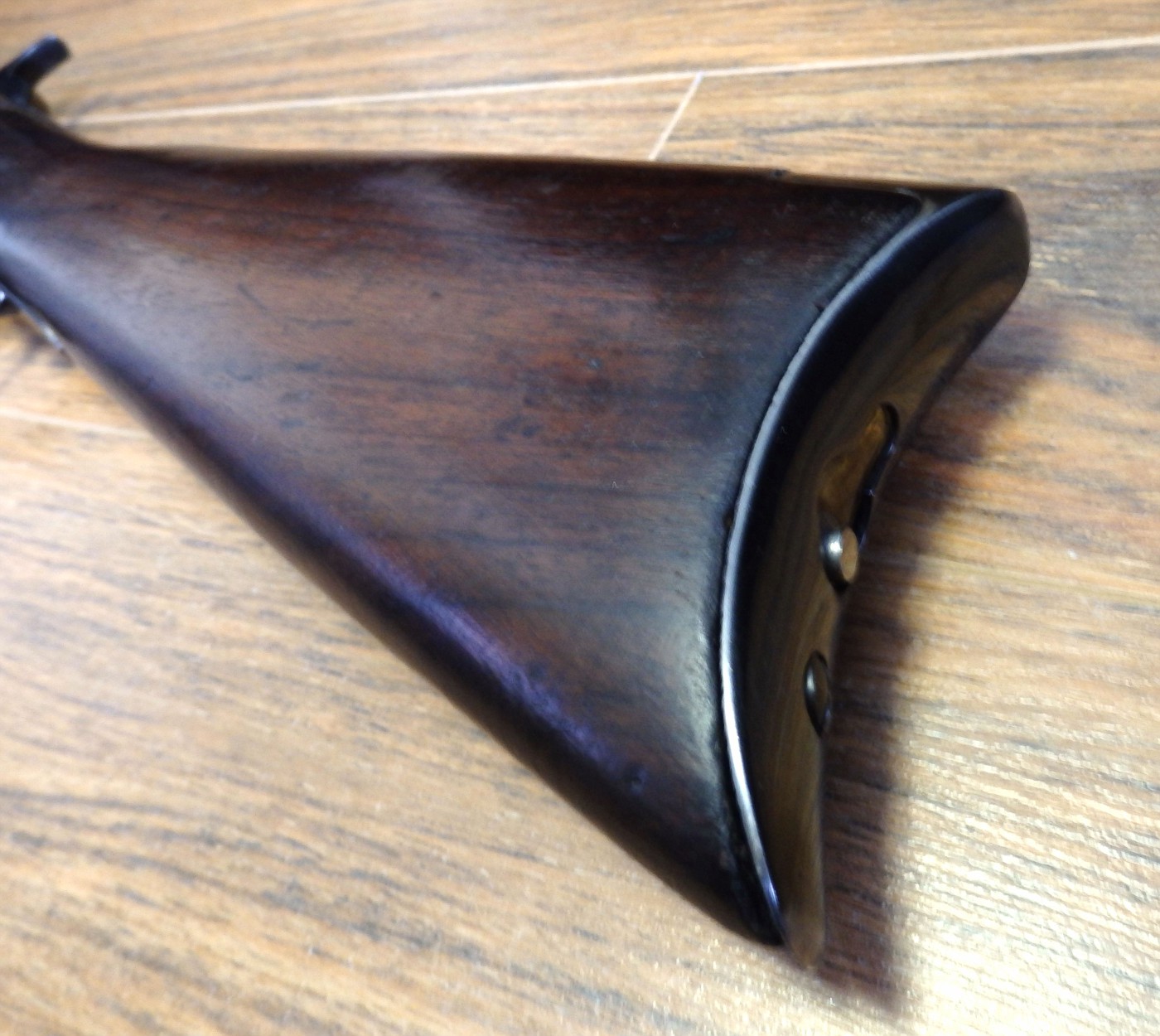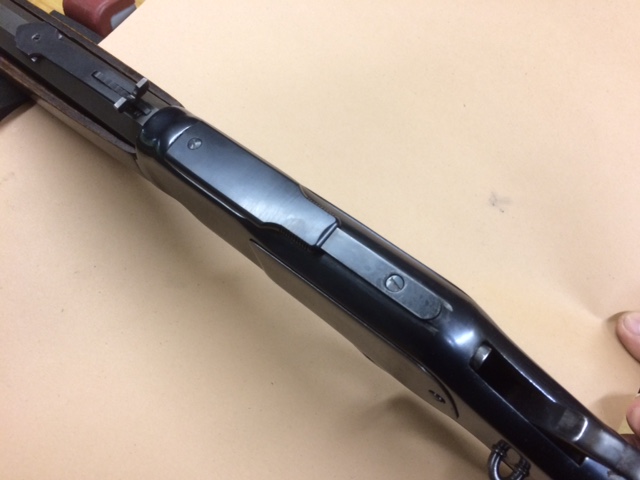I’m breathing new life into an old Winchester 1873. This is a parts gun so I’m not sure the bottom tang is the same vintage as the receiver. The serial number on the bottom tang is 133113A
I ordered a 2nd/3rd model dust cover from Homestead Parts
The replacement dustcover measures .330 at the widest part of the dovetail and the dove tail on the top of the receiver measures .300.
Was there another type of dustcover available at one time for these rifles with a narrower dovetail?
Any help would be appreciated
Dust covers were very close from one to the other, just minor fitting is needed. At .3″ its narrower than it should be. As I recall your gun was refinished so its possible the rail was cleaned up narrowing it also a gun that has been used a lot will have a worn rail. When I look at a 73, one of the things I check is the side to side play in the cover.
The only remedy you have beside replacing the receiver is to squeeze the dust cover in a vise. I have done this before on beater guns to get rid of excess play. Pad the vise with aluminum and take it slow. The dust cover will get taller when you squeeze it so it might look odd when on the gun and it can go south on you and you waste the cover.
Bob
WACA Life Member--- NRA Life Member---- Cody Firearms member since 1991 Researching the Winchester 1873's

Email: [email protected]
Thank Bob.
It doesn’t appear that anyone narrowed the dovetail on the top of the receiver. But after 140 years, you never know!
The rail on top of the receiver has very shallow dovetail. Even if I squeezed the dustcover, it wouldn’t “grab” the rails.
I think I’m going to have to make a new dustcover and fit it to the existing rail.
This rifle was a real challenge. I finally finished it and wil be writting an article cto my web site about it.
I measured a couple receivers in my parts bin and they all measure .330″ to .340″.
Bob
WACA Life Member--- NRA Life Member---- Cody Firearms member since 1991 Researching the Winchester 1873's

Email: [email protected]
That would work, Mill it off and screw on a second model rail.
Bob
WACA Life Member--- NRA Life Member---- Cody Firearms member since 1991 Researching the Winchester 1873's

Email: [email protected]
There are a couple of ways to fix the rail:
As been brought up earlier, you can machine the old rail off and screw a 2nd model rail in place.
For 3d models, I have machined off the old rail; I make a replacement rail out of 1018 with two holes in the top and spot welded (TIG) the rail in place. If you do a good job of making a flat on the top of the receiver (I use a surface grinder), the seam is nearly impossible to see.
I’m pretty sure that the rails that homestead sell are made out of 12L14, which will work great if you plan on screwing it in place, but not so good for welding as 12L has lead added, which causes serious porosity when TIG welding.
How much excess headspace are we talking about?
For excess headspace on a 73, you need to find out where the issue is.
You have a new barrel in the rifle, so it’s not wear at the chamber end of the barrel.
Have you checked the links and pins? Quite often the pins get worn, I would check those. Also check the pin at the “elbow” of the link. You will have to punch them out of the link, and check the holes in the link to make sure that they are not egg shaped, and check the pin.
I think that somewhere you mentioned that the links were new replacements. Winchester hasn’t manufactured the links in close to 100 years. So they are probably not Winchester factory replacements, and more than likely aftermarket. Not all aftermarket links are to Winchester factory specs. Ideally, when the links are fully extended, the square shoulder on the bolt should tight against the inside of the frame.
If the face of the bolt is worn, the old time method was to silver solder a shim to the face of the bolt.
At some point in the rifles life, someone took a file to the bolts face! I bet they screwed a barrel on and it was too little headspace so instead of taking some off the barrel, they filed the bolt nose.
Longer links won’t help because the bolt is 100% forward in the receiver.
I had to set the barrel back .050″ to headspace properly.
If I can’t find a new bolt I’m thinking about soldering a “washer” to the nose of the bolt and then facing it in the milling machine back to proper dimension.
Comments on this would be appreciated…….
Fortunately, even with the barrel stub intruding into the receiver, it still feeds fine (love a horizontal cartridge carrier)and my cartridge over all length is fine.
If mechanically OK , as per Mikes suggestions, cant you just back off your FLS die to make your cartridges snug again when fire-formed ? This would allow for increased size like an ‘Improved’ capacity cal. The way I see it there is no such thing as excess head space, as long as chamber is now stable dimensionally, and not getting worse. Its just a matter of adjusting loading dies to suit.
Phil

Yes it should headspace on the rim , however rather than set the barrel back , I have treated some as you would a rimless cartridge, and head space on the shoulder. This can easily be done by enlarging the neck diameter slightly (need a neck expander or mandrel about .020 larger )to create a false shoulder. Then bring down correct FLS bit by bit till action will close a bit snugly. Having good neck tension and setting the bullet into the lands will also help hold the case back so it fire-forms That is the new length and these oversized cartridges will be segregated for that gun. after fire-forming when you go to resize again, back the fls off again and adjust bit by bit till it touches new shoulder. See how this chambers. If possible leave the FLS at this setting for this gun only, or neck size only
Phil

Good ideas Phil,
I have a number of firearms in 38-40. All chambered with the same reamer with the exception of a couple Ubertis 1866 and 1873 rifles.
The 38-40 has nearly no shoulder to headspace on. And the brass is extremely thin so simple bolt cramming would size the brass to the chamber.
Because I shoot Cowboy Action competitively, my rifles need to run very fast. I shoot Black Powder with it’s associated fouling, therefore a bit of a proud chamber is desirable. We shoot upwards of 60 rounds in a morning without any time to clean the rifles in between matches. The thin brass of the 38-40 and 44-40 seal the chamber tightly and there is zero blowback. We shoot extremely mild loads to keep recoil to a minimum. With 45LC or 44SPL and its associated thicker brass cases, the brass does not expand at these low pressure levels and blowback is a major issue with black powder. I have a Colt lightning in 45LC that you need to rear a welders helmet to shoot safely the blow back is so bad!
A tight rim headspace and thin brass means there is never any residue to clean in the action of the rifle.
Updated the article with a dust cover fix:
http://rvbprecision.com/shooting/winchester-1873-saddle-ring-rifle-rebuild.html
1 Guest(s)


 Log In
Log In Members
Members Home
Home

 Add Reply
Add Reply Add Topic
Add Topic Offline
Offline












